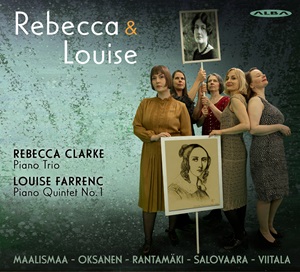
Rebecca & Louise
Rebecca Clarke (1886-1979)
Piano Trio (1921)
Louise Farrenc (1804 – 1875)
Piano Quintet No 1 in A minor, Op 30 (1839)
Mirka Viitala (piano), Reeta Maalismaa (violin), Aino Oksanen (viola), Tuija Rantamäki (cello), Kati Salovaara (double bass)
rec. 2022, Klaukkala, Finland
Alba ABCD 524 [52]
Any new musical ensemble faces one vexatious issue – ‘what shall we call ourselves?’ The group of Finnish musicians who have put together this CD have surmounted the problem by simply ignoring it; they are known by their individual names, although, who knows, that may change in the future. The fact is, they play wonderfully well together, and give passionately committed performances of these two fine compositions.
First comes the Piano Trio of Rebecca Clarke, daughter of a German mother and an American father, though born in London in 1886. The booklet notes (written by violinist Reeta Maalismaa’s sister Maija Alander) outline the struggles and disappointments of Clarke’s long life (she lived well into her 90s). But there can be no doubting her exceptional talent.
Her Piano Trio of 1921 is a powerful and expansive example of post-Romantic sonata form, unashamedly influenced by the German tradition. Yet many of the textures, as well as the harmonic language also betray her interest in composers of the French school, such as Franck and Debussy. All of this reminds one – as does the grittiness and uncompromising nature of her music – of her older contemporary Frank Bridge, who was like her, interestingly, a fine viola player.
The Piano Trio’s three movements are an excellent introduction to her style. The opening is aggressive and dissonant, the piano given strident 9ths, followed by nervous stuttering phrases in the strings. The sense of struggle against overwhelming odds is impressively sustained throughout, and these players rise to the challenge of this dramatic, sometimes expressionistic music. The slow movement does nothing to dispel the oppressive atmosphere; it’s only in the finale that the mood lightens, with rustic dance rhythms that sometimes put one in mind of Bartók.
Louise Farrenc was born in Paris in 1804 as Jeanne-Louise Dumont. Her parents were both successful sculptors, and the family was full of distinguished figures in the visual arts. She was a true child prodigy, and entered the Paris Conservatoire at the age of fifteen to study orchestration, piano and composition. In 1821, she married the flautist Aristide Farrenc, who became a successful music publisher, thus enabling Louise’s piano music to become well-known around Europe – Robert Schumann wrote favourably of her Piano Variations on a Russian Melody.
The Quintet Op 30 is written for the unusual combination of violin, viola, cello, double bass and piano, and when first performed in the 1840s did much to enhance Farrenc’s growing reputation. The influence of Schumann is easy to detect, but, as with Clarke, her own voice is always strongly present. She builds each movement with confidence and a sure sense of direction, the thematic material strongly characterised. I particularly enjoyed the rather Schubertian Adagio non troppo, relaxed and spacious, with a most expressive ‘cello solo at its start from Tuija Rantamäki. The third movement is a headlong Presto, and full marks to the players for taking it at its word and going like the wind – brilliant!
This is a fine issue, beautifully recorded, and presenting two powerful works which, it hardly needs saying, deserve to be far better known and more often played than they are at present. Hopefully this CD will play an important part in correcting that state of affairs.
Gwyn Parry-Jones
Help us financially by purchasing from



















